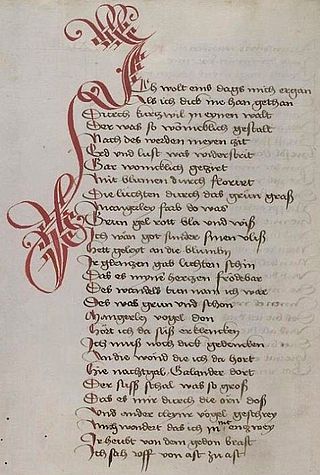
The Palatinate, or the Rhenish Palatinate (Rheinpfalz), is a historical region of Germany. Prior to World War II, it was also referred to as Rhenish Bavaria; as a state of the Holy Roman Empire, it was known as the Lower Palatinate (Unterpfalz), which designated only the western part of the Electorate of the Palatinate, as opposed to the Upper Palatinate (Oberpfalz). It occupies roughly the southernmost quarter of the German federal state of Rhineland-Palatinate (Rheinland-Pfalz), covering an area of 2,105 square miles (5,450 km2) with about 1.4 million inhabitants. Its residents are known as Palatines (Pfälzer).

Alzey is a Verband-free town – one belonging to no Verbandsgemeinde – in the Alzey-Worms district in Rhineland-Palatinate, Germany. It is the fifth-largest town in Rhenish Hesse, after Mainz, Worms, Ingelheim am Rhein and Bingen.

Neustadt an der Weinstraße is a town in Rhineland-Palatinate, Germany. With 53,300 inhabitants as of 2020, it is the largest town called Neustadt.

Forst an der Weinstraße is an Ortsgemeinde – a municipality belonging to a Verbandsgemeinde, a kind of collective municipality – in the Bad Dürkheim district in Rhineland-Palatinate, Germany.

Deidesheim is a town in the Bad Dürkheim district in Rhineland-Palatinate, Germany with some 3,700 inhabitants.

Lambrecht is a town in the Bad Dürkheim district in Rhineland-Palatinate, Germany lying roughly 6 km northwest of Neustadt an der Weinstraße. It is the seat of the like-named Verbandsgemeinde.

Kirchheim an der Weinstraße is an Ortsgemeinde – a municipality belonging to a Verbandsgemeinde, a kind of collective municipality – in the Bad Dürkheim district in Rhineland-Palatinate, Germany.

Ruppertsberg is an Ortsgemeinde – a municipality belonging to a Verbandsgemeinde, a kind of collective municipality – in the Bad Dürkheim district in Rhineland-Palatinate, Germany.

The Elwetritsch, plural Elwetritsche or Elwetritschen, is a birdlike legendary creature which is reported to be found in southwest Germany, especially in the Palatinate. The Elwetritsch can be seen as a local equivalent to mythical creatures of other regions.

Prince Adalbert of Bavaria was a member of the Bavarian Royal House of Wittelsbach, historian, author and a German Ambassador to Spain.

The Neustadt–Wissembourg railway, also called the Pfälzische Maximiliansbahn, Maximiliansbahn or just the Maxbahn - is a railway line in southwestern Germany that runs from Neustadt an der Weinstrasse to Wissembourg in Alsace, France. The Palatine Maximilian Railway also included a branch from Winden via Wörth and the Maxaubahn to Karlsruhe.
Johann Valentin Rathgeber was a German composer, organist and choirmaster of the Baroque Era.

The Leininger Sporn is a highly prominent ridge in the northeast of the Palatinate Forest in western Germany, mainly composed of the rock formations of the Middle and Upper Bunter. It forms the western edge of Upper Rhine Plain between Grünstadt in the north and Leistadt, a village in the county of Bad Dürkheim, in the southeast. In the natural region system of the German Central Uplands it is considered one of the four sub-units of the Middle Palatinate Forest.

Walking routes in the Palatine Forest fall into two categories. The first are longer walking routes, most of which are maintained by the Palatine Forest Club, or PWV, and which are linked to the national and international network of long distance paths. The second category are those local circular walks and themed walking routes, some of which are of wider regional importance, and which are maintained by municipal authorities. The Palatine Forest, as part of the Palatine Forest-North Vosges Biosphere Reserve, is an important conservation area. As a result, the Palatine Forest, the bunter sandstone landscape of the Palatine Forest Nature Park, the castles in the Dahner Felsenland and the cross-border paths into Alsace and the Vosges make the region particularly popular with ramblers and walkers.
Alexander Rubel is a German-Romanian historian of the Antiquity.

Hambach, which received its name affix "an der Weinstraße" as a wine village in 1935, was incorporated into the town Neustadt an der Weinstraße (Rhineland-Palatinate) in 1969 and is its second largest district. The village is considered a symbol of German democracy because of the enunciation of freedom which took place in the Hambach Castle in 1832, known as the Hambach Festival.

Isabel Mackensen-Geis is a German politician of the Social Democratic Party (SPD) and member of the Bundestag, the German parliament, since 2019.

Otto Rumpf was a German sculptor.

The Minnerede is a form of late medieval rhyming speech. In contrast to the shorter Minnelieder in canzonal form, it was not sung but spoken. Most of the texts have only a few hundred verses, the Minnereden, which is assigned to around 600 texts in German studies, but also extensive texts such as 'Die Minneburg', 'Die Minnelehre' by Johann von Konstanz, 'The Hunt' by Hadamar von Laber and 'Mörin' by Hermann von Sachsenheim counted. The rhyming couplet verse is predominant, but there are also some strophic minnereden. Many Minnereden are reflections on courtly love held in first-person form or narratives of allegorical events and dreams, the focus of which is the unfulfilled desire of the Minnenden.























